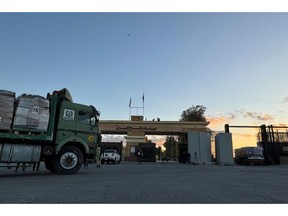The opening of the crossing between the Gaza Strip and Egypt remains suspended, despite calls from the UN and aid groups.

Contents of the article
CAIRO – The opening of the Rafah border crossing between the Gaza Strip and Egypt, part of US President Donald Trump's plan for the Palestinian territory, remains suspended despite calls from the UN and aid groups.
Advertisement 2
Contents of the article
Here are five things to know about this important move:
Contents of the article
Contents of the article
– Critical access point –
The Rafah crossing into Egypt is an important entry point for aid workers and trucks carrying aid, food and fuel needed for daily life in the area without electricity.
The crossing has long been the main exit point for Palestinians from Gaza, who have been allowed to leave the narrow strip of land under an Israeli blockade since 2007.
From 2005 to 2007, it was the first Palestinian border terminal controlled by the Palestinian Authority.
It then became one of the symbols of Hamas's control over the Gaza Strip.
– Under Israeli control –
On May 7, 2024, the Israeli army took control of the Palestinian side, declaring that the crossing was “being used for terrorist purposes” amid suspicions of arms trafficking.
Contents of the article
Advertisement 3
Contents of the article
Since then, access points have largely been closed, including those used by the United Nations.
Rafah briefly reopened during a short-lived ceasefire between Israel and Hamas that took effect on Jan. 19, first allowing passage for people allowed to leave the Gaza Strip and then for trucks.
– Opening soon? –
After the ceasefire initiated by Trump took effect, Israeli Foreign Minister Gideon Sa'ar mentioned plans to restart the fire, but the Israeli Prime Minister's Office ultimately announced that the crossing would remain closed “until further notice.”
According to COGAT, the Israeli Defense Ministry body that oversees civil affairs in the Palestinian territories, the crossing is to be opened “for the movement of people only.”
Advertisement 4
Contents of the article
Trump's plan, which underpins the ceasefire between Israel and Hamas, calls for the area to be made available again for international humanitarian aid and the Rafah crossing to reopen.
But since the ceasefire took effect on October 10, Israeli authorities have stalled on the issue, citing Hamas' failure to return the bodies of all hostages and then the need to coordinate with Egypt before launching air strikes on Sunday over alleged Hamas abuses.
— Kerem Shalom —
International aid usually arrives in Egypt through the ports of Port Said or El Arish, the cities closest to the Gaza Strip, where hundreds of aid trucks wait to cross the border.
According to drivers, after passing through the Rafah checkpoint, the trucks head to the Israeli Kerem Shalom checkpoint, located a few kilometers (miles) away.
Advertisement 5
Contents of the article
There, drivers unload their vehicles for inspection.
After strict checks, goods allowed to enter are unloaded and then reloaded into other vehicles allowed to enter Gaza.
– Other intersections –
The agreement brokered by Trump allows for 600 trucks per day.
According to the UN, Israel is currently allowing humanitarian aid in smaller quantities: three-quarters of it through the Kerem Shalom crossing and the rest through the Kissufim crossing.
The Erez, or Beit Hanoun, crossing between the Gaza Strip and southern Israel was destroyed by Hamas militants during an attack on Israel on October 7, 2023.
Briefly reopened in early 2025, it is currently closed with no opening date set.
Other hotspots were open in the past, but Israeli authorities have not said whether they will reopen.
Contents of the article







